Your Complete Maryland Lawn Care Schedule - Tips for The Perfect Lawn
Keeping up with all of your lawn’s needs during the year is not always easy.
You want to do the best for your yard, but by the time you realize what month it is, you’re seeing weeds or your grass color looks sketchy. This makes you think that maybe you should have done something months ago to prevent these issues. And when was the last time you fertilized?
Also, your lawn is something all the neighbors see when they pass your Maryland home. So, it’s not like you can hide the blemishes when it’s not looking good.
We get it. Life happens.
But maybe a guide showing you what you need to do to your lawn season-by-season could help? Here is a lawn care calendar you can use to stay on track.
Your Complete Lawn Care Schedule for Maryland
While you might think lawn care is a one time thing, there is actually something important to do during each season when it comes to adhering to a lawn maintenance schedule.
We want to help you understand what’s involved and why it helps your lawn thrive.
Winter Lawn Care
Think there’s nothing you need to do for your lawn in the winter? Just sit back with your warm coffee and stay by the cozy fireplace without a worry?
Think again. As long as the ground isn’t frozen in January and February, there are some things you can add to your lawn care calendar to make it better for the upcoming season.
For instance, you can use a root growth stimulator, which is like a probiotic for your lawn. While this can be done at any time of year, it’s best done during cooler months because that’s when the roots are really expanding and developing. These applications are great for lawns that have been planted on poor soil, such those that went through recent home construction.
Lime applications can also happen at this time of the year. If after a soil test, you find out your lawn soil is too acidic, then lime can help balance this out. 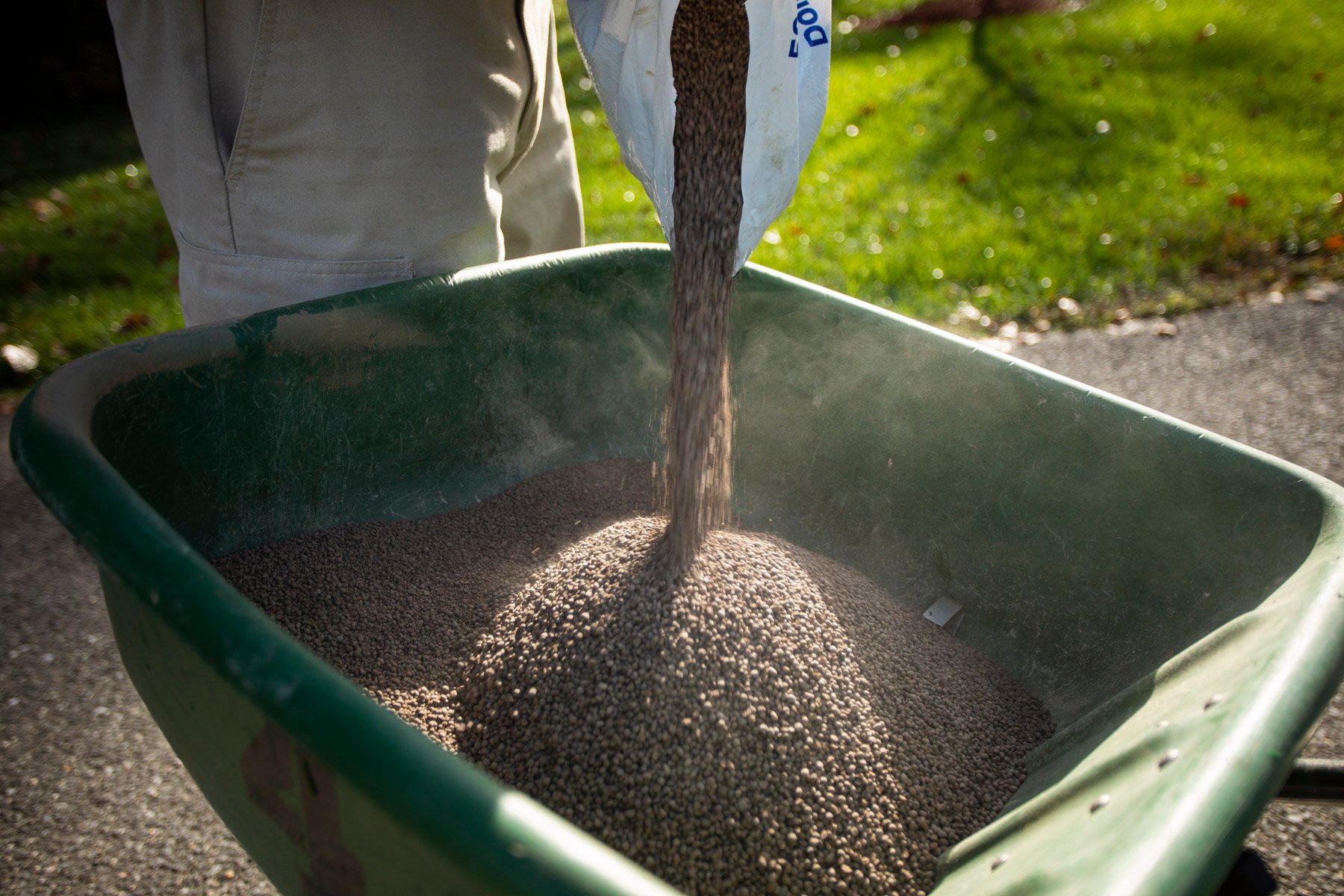 No matter what the weather does, Maryland does have blackout dates when you cannot put down any fertilizer. This lasts from December 1 to March 1. These state rules are in place to help protect the Chesapeake Bay.
No matter what the weather does, Maryland does have blackout dates when you cannot put down any fertilizer. This lasts from December 1 to March 1. These state rules are in place to help protect the Chesapeake Bay.
Early Spring Lawn Care
This is a great time of year to get some things ready for the busy spring season ahead. And these necessities on your Maryland lawn care schedule can’t be ignored or it may put you behind once that growing season kicks into full gear.
Start by cleaning up your yard. Lightly rake up dead leaves and debris. You don’t want to be too aggressive and pull out chunks of lawn, but you do want to clear the lawn so it can prepare to grow, receiving the sunlight, air, water, and other nutrients it needs.
Next, prep your mower for the busy times ahead. This includes sharpening those mower blades, filling the tires with air, changing the oil, and making sure everything works properly. These are things you’ll want to continue checking a few more times through the growing season. 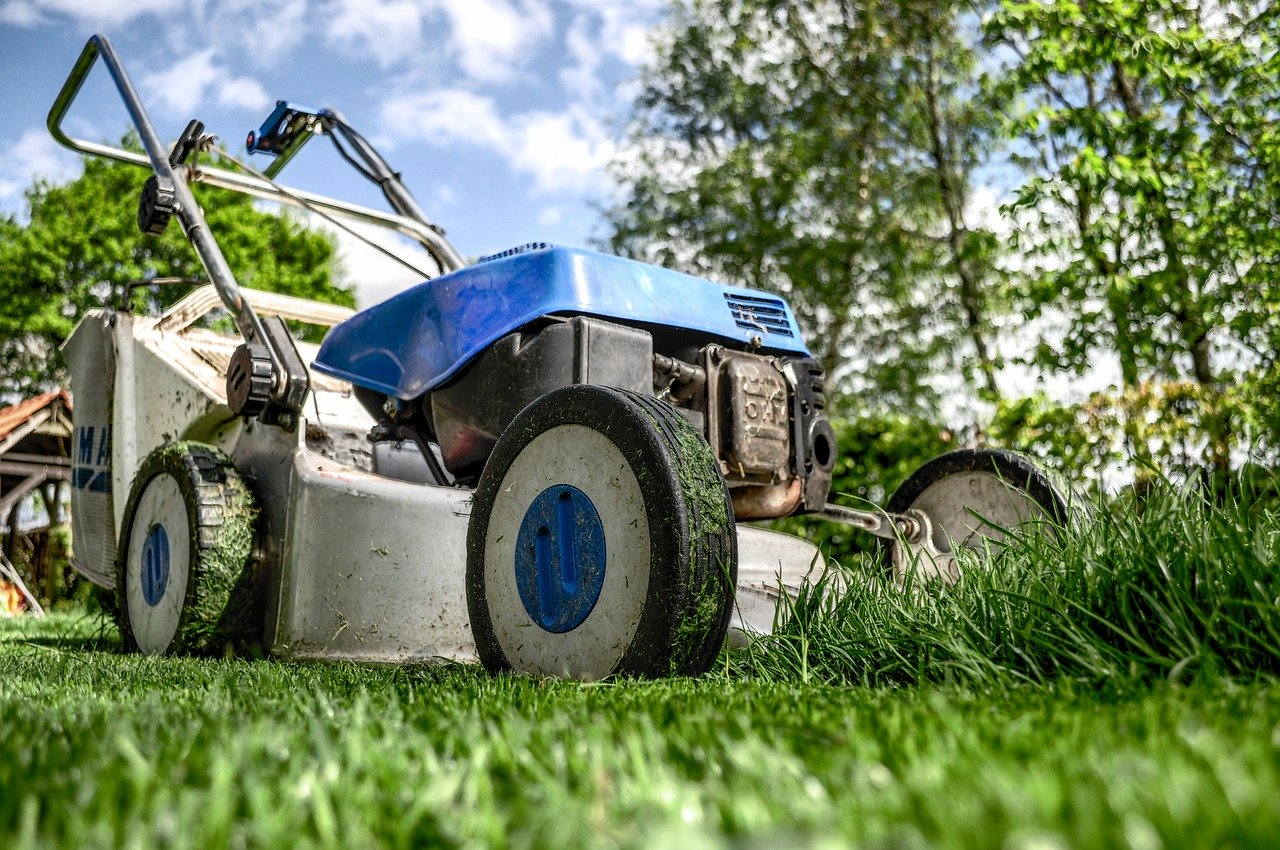 Once March 1 hits, you’re able to fertilize for the first time. This ensures your lawn has the nutrients available when the plants begin adding top growth, as well as maintains turf vigor and density.
Once March 1 hits, you’re able to fertilize for the first time. This ensures your lawn has the nutrients available when the plants begin adding top growth, as well as maintains turf vigor and density.
And while you’re fertilizing, this is a great time of year to put down a pre-emergent herbicide to get ahead of crabgrass and other annual grassy weeds before they pop up.
Keep your eyes open for bare spots or areas where your lawn seems impacted by snow mold, salt, or snow plow damage. You may want to flag these areas for seeding and repair later.
Late Spring Lawn Care
As you get solidly into spring, remember to continue mowing your grass approximately weekly. It should be 3 to 4 inches tall after you mow it, and you should never remove more than one-third of the lawn at any one time.
This is also the time on your lawn maintenance calendar for a second fertilization treatment, as well as a second pre-emergent herbicide application. 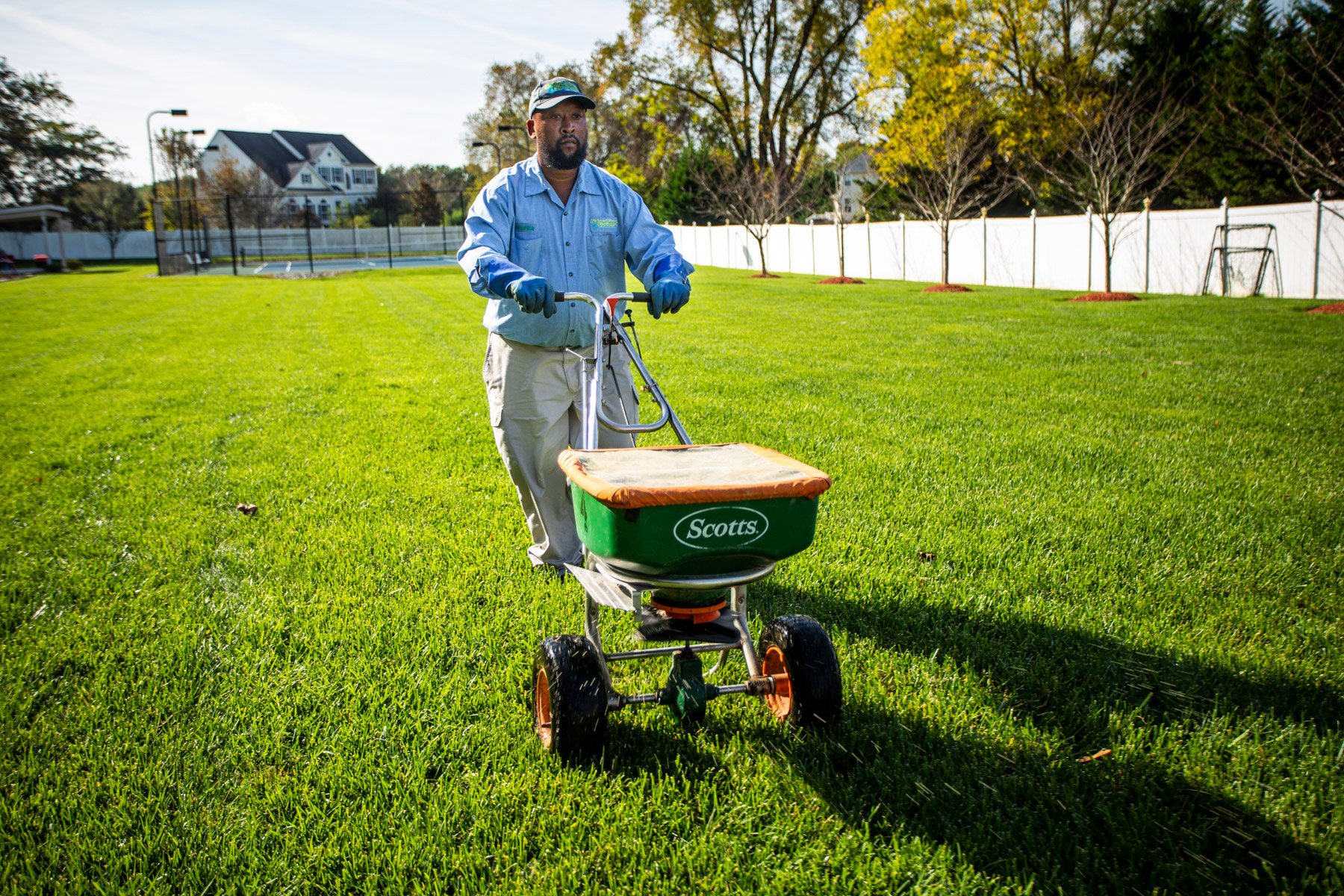 Pre-emergent herbicides are commonly applied half earlier in the spring and half later to help control those sneaky weeds that aren’t operating on your schedule. It provides an extended period of control, acting as a safety blanket of sorts.
Pre-emergent herbicides are commonly applied half earlier in the spring and half later to help control those sneaky weeds that aren’t operating on your schedule. It provides an extended period of control, acting as a safety blanket of sorts.
Early Summer Lawn Care
Your lawn should look pretty good right now after all the work you’ve done following your Maryland lawn care schedule earlier in the year.
Mowing is usually at its peak during spring and then again in fall. So mowing may start to slow down a bit during the hotter summer months.
Next, you’ll be applying a third fertilization treatment -- a nice slow-release blend. You’ll also want to switch to a post-emergent herbicide application when necessary to tackle stubborn weeds that escaped your pre-emergent control or broke through on bare lawn areas that are less healthy.
Now you’ll also want to start watching for any insect pests or diseases or other lawn problems that can erupt. Surface and subsurface insects can appear now; we’re talking about chinch bugs, cutworms, and sod webworms. If you have a grub problem, preventing them now before they hatch and cause lawn damage is crucial.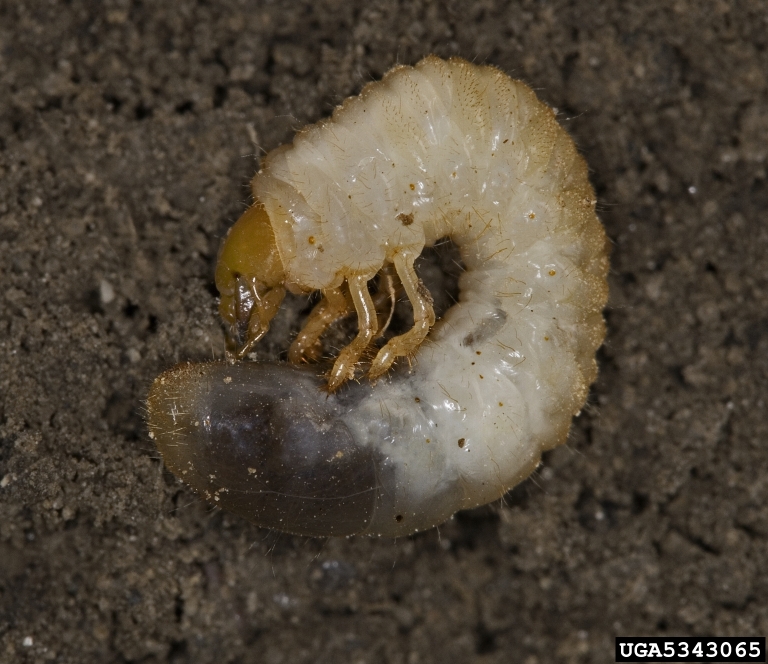
Late Summer Lawn Care
Don’t forget your mowing. At this point, growth may start to increase again as summer temperatures cool. Typically, you should be mowing every five days in spring and fall and every 10 days in early spring, summer, and late fall.
Have you been watering your lawn? You may have received enough water from rain during the spring and early summer, but once summer settles in, you should be watering one to two times weekly for approximately 45 to 60 minutes. Think of providing a good soaking less frequently.
This is another time on your lawn care calendar for a slow-release fertilizer application to prepare your lawn for fall growth.
Fall Lawn Care
It’s fall! Now it’s time for fall fertilization on your Maryland lawn care schedule.
But all these nutrients need to reach your lawn roots to give you your goal of thicker, greener grass. From traffic and just normal compaction, lawns absorb fewer nutrients. This is the perfect time of year for aeration to break up the soil and give your lawn a chance to breathe. 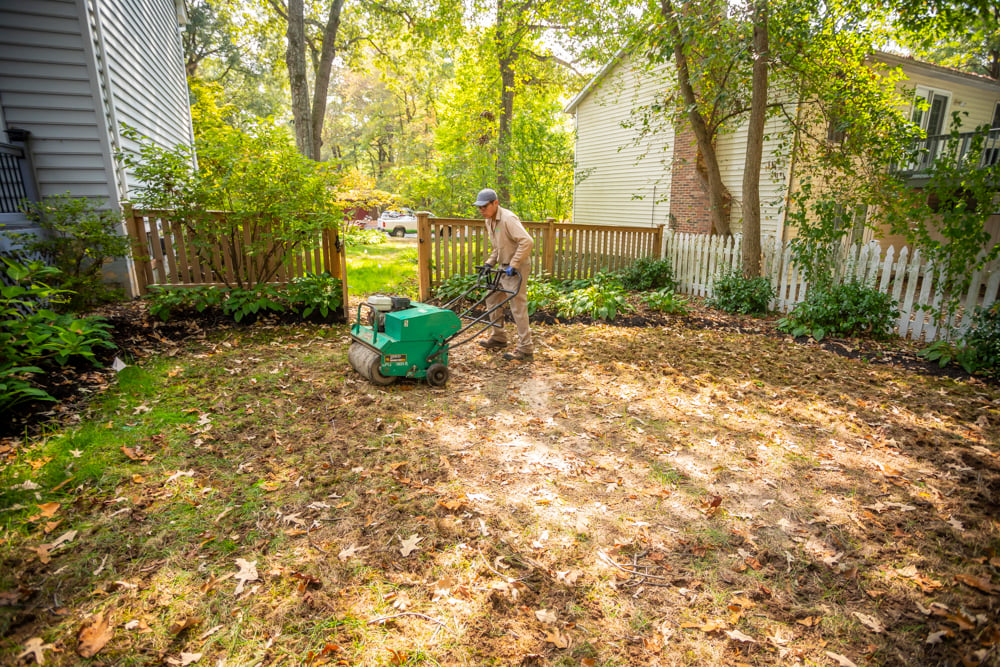 If you noticed any barren patches or areas where your lawn needs filled in, aeration creates that perfect environment for overseeding. The temperatures are also great for growing a lawn so seeding at this time is ideal.
If you noticed any barren patches or areas where your lawn needs filled in, aeration creates that perfect environment for overseeding. The temperatures are also great for growing a lawn so seeding at this time is ideal.
Fall is also the final time to do a comprehensive weed control using a post-emergent herbicide for cool-season weeds.
Embrace the Schedule for a Great Lawn
Tending to your lawn is time consuming. To succeed, you should know which grass species you have, and maintain proper mowing, watering, fertilizing, weed control, and other treatments to ensure lawn vigor and success. And we hope following this lawn care schedule helps you stay on top of the chore.
This process can certainly be daunting, and it’s easy to get confused. We completely understand. Who wants to waste their time, especially if they aren’t sure whether or not what they’re doing is working.
Want your weekend time back? We’re happy to take this job off of your hands. You can choose from our different lawn care programs based on the results you’re after and your budget.
Want to learn more about how to get a great lawn in Central and Southern Maryland? Get started today with a free quote. We’ll review your options together so you can make a great choice. Then you can just sit back and enjoy your lawn.
Image Source: Lawn Mower, Grub
Keeping up with all of your lawn’s needs during the year is not always easy.
You want to do the best for your yard, but by the time you realize what month it is, you’re seeing weeds or your grass color looks sketchy. This makes you think that maybe you should have done something months ago to prevent these issues. And when was the last time you fertilized?
Also, your lawn is something all the neighbors see when they pass your Maryland home. So, it’s not like you can hide the blemishes when it’s not looking good.
We get it. Life happens.
But maybe a guide showing you what you need to do to your lawn season-by-season could help? Here is a lawn care calendar you can use to stay on track.
Your Complete Lawn Care Schedule for Maryland
While you might think lawn care is a one time thing, there is actually something important to do during each season when it comes to adhering to a lawn maintenance schedule.
We want to help you understand what’s involved and why it helps your lawn thrive.
Winter Lawn Care
Think there’s nothing you need to do for your lawn in the winter? Just sit back with your warm coffee and stay by the cozy fireplace without a worry?
Think again. As long as the ground isn’t frozen in January and February, there are some things you can add to your lawn care calendar to make it better for the upcoming season.
For instance, you can use a root growth stimulator, which is like a probiotic for your lawn. While this can be done at any time of year, it’s best done during cooler months because that’s when the roots are really expanding and developing. These applications are great for lawns that have been planted on poor soil, such those that went through recent home construction.
Lime applications can also happen at this time of the year. If after a soil test, you find out your lawn soil is too acidic, then lime can help balance this out.  No matter what the weather does, Maryland does have blackout dates when you cannot put down any fertilizer. This lasts from December 1 to March 1. These state rules are in place to help protect the Chesapeake Bay.
No matter what the weather does, Maryland does have blackout dates when you cannot put down any fertilizer. This lasts from December 1 to March 1. These state rules are in place to help protect the Chesapeake Bay.
Early Spring Lawn Care
This is a great time of year to get some things ready for the busy spring season ahead. And these necessities on your Maryland lawn care schedule can’t be ignored or it may put you behind once that growing season kicks into full gear.
Start by cleaning up your yard. Lightly rake up dead leaves and debris. You don’t want to be too aggressive and pull out chunks of lawn, but you do want to clear the lawn so it can prepare to grow, receiving the sunlight, air, water, and other nutrients it needs.
Next, prep your mower for the busy times ahead. This includes sharpening those mower blades, filling the tires with air, changing the oil, and making sure everything works properly. These are things you’ll want to continue checking a few more times through the growing season.  Once March 1 hits, you’re able to fertilize for the first time. This ensures your lawn has the nutrients available when the plants begin adding top growth, as well as maintains turf vigor and density.
Once March 1 hits, you’re able to fertilize for the first time. This ensures your lawn has the nutrients available when the plants begin adding top growth, as well as maintains turf vigor and density.
And while you’re fertilizing, this is a great time of year to put down a pre-emergent herbicide to get ahead of crabgrass and other annual grassy weeds before they pop up.
Keep your eyes open for bare spots or areas where your lawn seems impacted by snow mold, salt, or snow plow damage. You may want to flag these areas for seeding and repair later.
Late Spring Lawn Care
As you get solidly into spring, remember to continue mowing your grass approximately weekly. It should be 3 to 4 inches tall after you mow it, and you should never remove more than one-third of the lawn at any one time.
This is also the time on your lawn maintenance calendar for a second fertilization treatment, as well as a second pre-emergent herbicide application.  Pre-emergent herbicides are commonly applied half earlier in the spring and half later to help control those sneaky weeds that aren’t operating on your schedule. It provides an extended period of control, acting as a safety blanket of sorts.
Pre-emergent herbicides are commonly applied half earlier in the spring and half later to help control those sneaky weeds that aren’t operating on your schedule. It provides an extended period of control, acting as a safety blanket of sorts.
Early Summer Lawn Care
Your lawn should look pretty good right now after all the work you’ve done following your Maryland lawn care schedule earlier in the year.
Mowing is usually at its peak during spring and then again in fall. So mowing may start to slow down a bit during the hotter summer months.
Next, you’ll be applying a third fertilization treatment -- a nice slow-release blend. You’ll also want to switch to a post-emergent herbicide application when necessary to tackle stubborn weeds that escaped your pre-emergent control or broke through on bare lawn areas that are less healthy.
Now you’ll also want to start watching for any insect pests or diseases or other lawn problems that can erupt. Surface and subsurface insects can appear now; we’re talking about chinch bugs, cutworms, and sod webworms. If you have a grub problem, preventing them now before they hatch and cause lawn damage is crucial.
Late Summer Lawn Care
Don’t forget your mowing. At this point, growth may start to increase again as summer temperatures cool. Typically, you should be mowing every five days in spring and fall and every 10 days in early spring, summer, and late fall.
Have you been watering your lawn? You may have received enough water from rain during the spring and early summer, but once summer settles in, you should be watering one to two times weekly for approximately 45 to 60 minutes. Think of providing a good soaking less frequently.
This is another time on your lawn care calendar for a slow-release fertilizer application to prepare your lawn for fall growth.
Fall Lawn Care
It’s fall! Now it’s time for fall fertilization on your Maryland lawn care schedule.
But all these nutrients need to reach your lawn roots to give you your goal of thicker, greener grass. From traffic and just normal compaction, lawns absorb fewer nutrients. This is the perfect time of year for aeration to break up the soil and give your lawn a chance to breathe.  If you noticed any barren patches or areas where your lawn needs filled in, aeration creates that perfect environment for overseeding. The temperatures are also great for growing a lawn so seeding at this time is ideal.
If you noticed any barren patches or areas where your lawn needs filled in, aeration creates that perfect environment for overseeding. The temperatures are also great for growing a lawn so seeding at this time is ideal.
Fall is also the final time to do a comprehensive weed control using a post-emergent herbicide for cool-season weeds.
Embrace the Schedule for a Great Lawn
Tending to your lawn is time consuming. To succeed, you should know which grass species you have, and maintain proper mowing, watering, fertilizing, weed control, and other treatments to ensure lawn vigor and success. And we hope following this lawn care schedule helps you stay on top of the chore.
This process can certainly be daunting, and it’s easy to get confused. We completely understand. Who wants to waste their time, especially if they aren’t sure whether or not what they’re doing is working.
Want your weekend time back? We’re happy to take this job off of your hands. You can choose from our different lawn care programs based on the results you’re after and your budget.
Want to learn more about how to get a great lawn in Central and Southern Maryland? Get started today with a free quote. We’ll review your options together so you can make a great choice. Then you can just sit back and enjoy your lawn.
Image Source: Lawn Mower, Grub
Share This
Topics: Lawn Care


